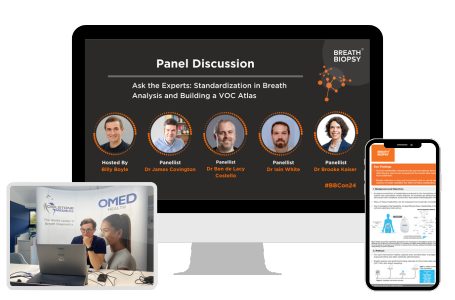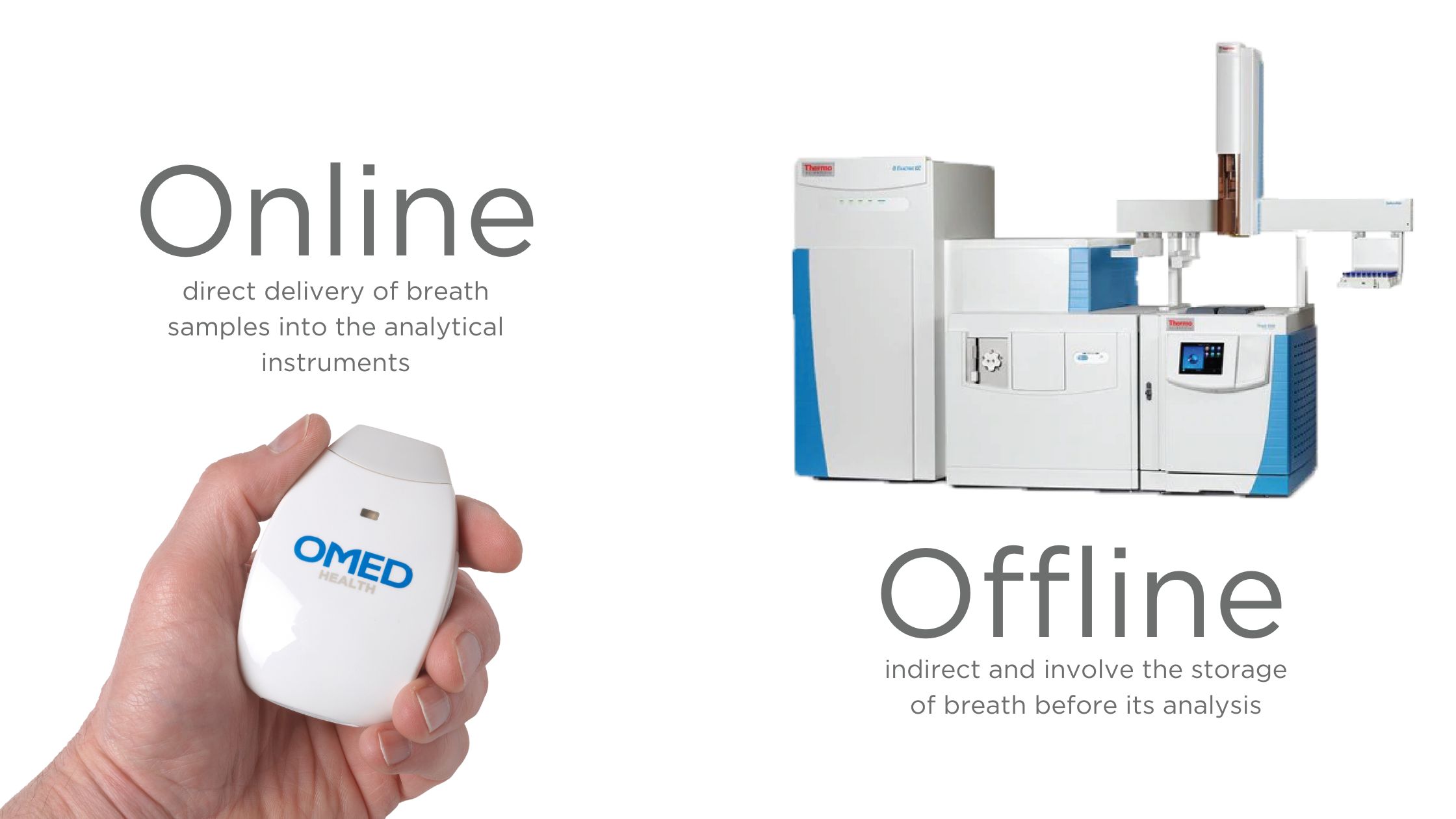Online vs Offline Techniques for Breath Analysis
Published on: 27 Jun 2024
Breath sampling approaches can generally be split into two categories: online and offline. Online sampling techniques involve the direct delivery of breath samples into the analytical instruments, whereas offline techniques are indirect and involve the storage of breath before its analysis (1). Each of these techniques have different advantages and disadvantages that make them appropriate for a variety of applications.
Offline Techniques
Offline breath sampling techniques are currently considered the gold standard technique for breath sampling given the wealth and accuracy of information that they can provide. Specifically, gas chromatography-mass spectrometry (GC-MS) is seen as the benchmark technique for the identification and validation of VOCs in exhaled breath samples. However, the complex pre-sample processing and expert knowledge required to analyze results currently limits its use in a clinical setting (1), where there is a need for cheap, fast, and accessible solutions.
Challenges with storage and transportation in offline analytical techniques have traditionally complicated the logistics of breath analysis. Whilst able to store large amounts of breath, Tedlar bags are not ideal for transport and long-term storage of samples, with particular susceptibility to background VOC contamination from compounds such as N,N-dimethylacetamide and phenol which come from the bag material and possible leaks that lose sample (2). At Owlstone Medical, we use sorbent tubes for the storage of the breath samples that we collect. The tubes are made of a combination of a porous polymer and graphitized carbon that have been specifically designed to collect a wide range of compounds across a range of carbon chain lengths and boiling points. These internal collection materials can also be modified to collect different, more specific ranges of molecules. Water can be easily removed from the sorbent tubes by dry purging, improving the storage and preservation of samples before analysis is ready to be conducted.
Our sorbent tubes also allow the concentration of breath samples before they are analysed. Each individual tube collects the VOCs from up to 1.5 L of breath, with the compact cartridges of four tubes that are used to take the Breath Biopsy samples taking up minimal storage space for easy transportation. This helps to contribute to the high sensitivity detection of low abundance VOCs within breath samples, increasing the range of VOCs available to be reliably detected and identified from exhaled breath.
High Resolution Accurate Mass (HRAM) GC-MS is one of the advanced mass spectrometry technologies utilized in breath analysis. This technique can identify compounds by matching signals to a large base of reference standards found in existing compound libraries. At Owlstone Medical, we identify and validate compounds using HRAM libraries in combination with our own database of compounds verified as being ‘on-breath’; the Breath Biopsy Atlas. The Atlas contains a wide range of identified and quantified volatile organic compounds (VOCs) found in exhaled breath, enabling the high-confidence identification of on-breath compounds. The library also provides scientific contexts to the VOCs identified, with the goal of enabling confidence in the selection of potential biomarkers that may be associated with specific biological pathways and disease processes. Understanding the metabolic origin of breath biomarkers is essential for the demonstration of disease relevance to establish clinical validity. The identification of VOCs is usually much higher fidelity for offline techniques in comparison to online techniques and is an essential step in the development of targeted sampling techniques that would be more appropriate for the clinical environment, potentially in the form of an online sampling technique.
Dr. Kamila Schmidt from the University of Manchester recently presented at the Breath Biopsy Conference 2024, on ‘Offline Breath Analysis: Storing up Trouble?’. You can watch Dr. Schmidt’s talk on-demand, as well as the rest of the presentations from the conference here.
Online Techniques
The direct introduction of breath samples to analysis technology in online techniques negates any need for sample storage or transport, improving the logistics of breath testing. Therefore, online techniques are generally designed to be more portable than offline techniques, improving ease of use. However, as a compromise for the rapid results and portability of most current online techniques, these methods currently lack the ability to identify compounds with high fidelity. This is because chromatographic separation and analytical detectors are often simplified in online techniques due to the desire to make the instruments for analysis more portable (1). This means that current online instruments lack the same pre-separation stages as offline techniques resulting in a reduced ability to identify compounds with high fidelity. In the case of multiple sensor-array technologies like Electronic Nose (eNose), these rely on the recognition of breath fingerprints in place of exact mass-based identification of compounds for their analysis (3). However, with continued development and improvements in online technology, progress is being made towards this goal, and will continue to do so.
At Owlstone Medical, we have developed our patented Field Asymmetric Ion Mobility Spectrometry (FAIMS) technology that is able to detect VOC biomarkers with high sensitivity and selectivity. FAIMS is a form of ion mobility spectrometry that distinguishes charged gaseous molecules according to the speed at which they move through a buffer gas in an oscillating electric field. Compared to other sensor-based systems like eNose technologies, FAIMS technology has highly sensitive and selective sensing, as it bypasses the shortfalls of limited temporal stability, poor chemical selectivity, and poor repeatability in non-selective chemical sensors.
One of the greatest advantages of online breath testing is its potential for the development of easy-to-use point-of-care (POC) tests able to deliver rapid results. These devices provide fast, cheap, and accessible solutions by skipping the complex pre-sample processing and expert knowledge required by most offline techniques. Owlstone Medical is rapidly making progress towards the production of POC tests with the development our portable breath analyzer for hydrogen and methane through our OMED Health platform. Hydrogen and methane levels in the breath are linked to the activity of the gut microbiome, and are used clinically in the diagnosis of certain conditions such as small intestinal bacterial overgrowth (SIBO), lactose intolerance, and fructose intolerance. By analyzing the levels of hydrogen and methane found in the breath in conjunction with symptoms of GI discomfort (which can be tracked in the paired OMED Health app), you can gain insights into the potential causes or triggers of symptoms, including diet, sleep, stress, and other underlying factors. The development of this device is a great step forward in the field of online breath analysis, providing a useful platform to build upon for the development of further POC breath tests for different compounds and diseases, potentially playing an essential role in the future of healthcare.
References:
- Ibrahim W, Carr L, Cordell R, Wilde M, Salman D, Monks PS, et al. Breathomics for the Clinician: The use of volatile organic compounds in respiratory diseases. Thorax. 2021 May 1;76(5):514–21. DOI: 10.1136/thoraxjnl-2020-215667
- Westphal K, Dudzik D, Waszczuk-Jankowska M, Graff B, Narkiewicz K, Markuszewski MJ. Common Strategies and Factors Affecting Off-Line Breath Sampling and Volatile Organic Compounds Analysis Using Thermal Desorption-Gas Chromatography-Mass Spectrometry (TD-GC-MS). Metabolites [Internet]. 2023 Jan [cited 2024 Apr 8];13(1). Available from: https://www.ncbi.nlm.nih.gov/pmc/articles/PMC9866406/. DOI: 10.3390/metabo13010008
- Haworth JJ, Pitcher CK, Ferrandino G, Hobson AR, Pappan KL, Lawson JLD. Breathing new life into clinical testing and diagnostics: perspectives on volatile biomarkers from breath. Crit Rev Clin Lab Sci. 2022 Jul 4;59(5):353–72. DOI: 10.1080/10408363.2022.2038075.
Catch up on the presentations from the Breath Biopsy Conference 2024

